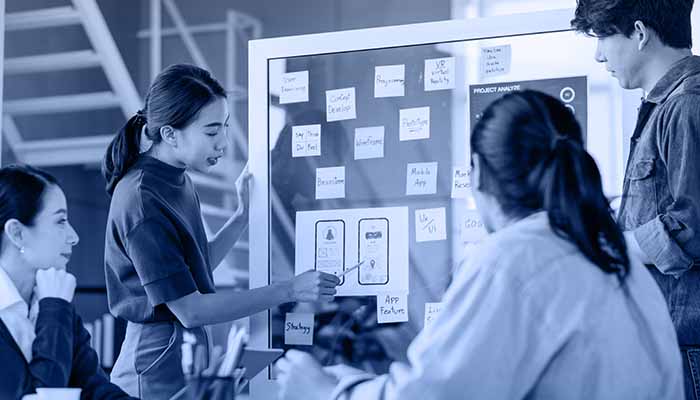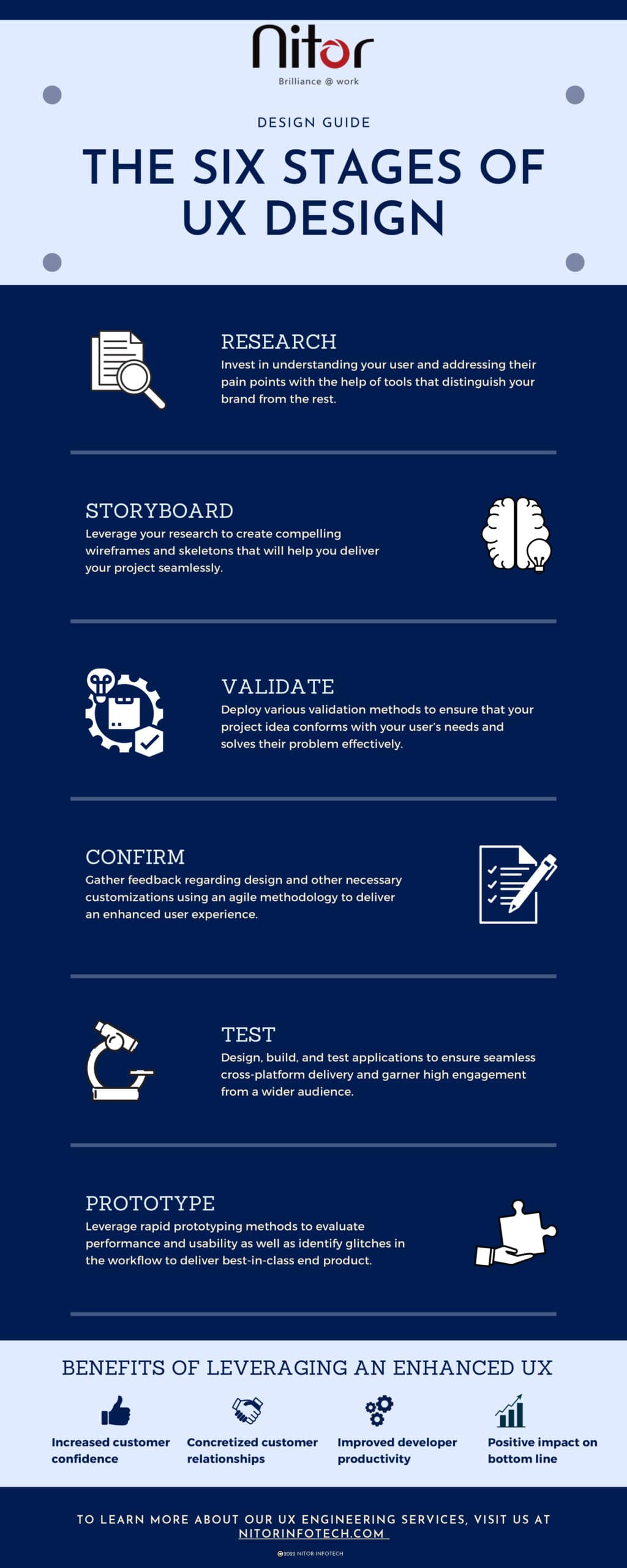Digital Transformation | 08 Apr 2022 | 11 min
What is UX Design? Implement it in Six Stages

As the end user of a product or a service, what matters to you the most is how easy and pleasant it is for you to accomplish the tasks you want to do with the help of the product or service. Well, UX design considers every element that impacts this experience. It is all about positioning the user at the forefront of the design through market research, product development, strategy, and design thinking. When done right, it brings delightful user experiences into reality.

Allow me to elaborate on what each of these six stages entails:
Realistic research is a vital part of the UX design process. A journey of UX research can typically begin with qualitative measures, to identify the users’ motivations and pain points. Quantitative measures could be used to test their results. You will want to take a structured approach when you collect data from your users. Do use methods that suit your research purpose and will give you clear data.
Following this, you can analyse your findings to incorporate handy insights into your design and identify distinct tools that are likely to help your brand stand out in the crowd!
Who doesn’t enjoy a good story? Wouldn’t you agree that a well-told story attracts attention, offers clarity, and inspires relevant stakeholders to act? Now a storyboard conveys a story through beautiful images displayed in a sequence of panels that systematically portrays the major happenings in the story.
Did you know that storyboards can augment journey maps by including an image of the user’s context while they interact with a product? Envisioning a user’s device, office space, and so on, can help your team empathize with your user. In case of a service, the future scenarios portrayed in a storyboard help you to clearly visualise the value that your service would be adding to the user’s life. These storyboards can be made through collaboration with users too.
It’s all about achieving a sufficiently captivating outline, which could be using wireframes, visual design, and style guides as well.
Here comes the million-dollar question: How do you know whether your design is awesome? The stage of validation goes beyond a “This is good!” from the stakeholder. Real validation comes from users who perceive real value in using your product or availing of your service.
Which is why it’s an excellent idea to always keep your target users in mind and find great representatives. Imagine the environment they’ll be using that product (or experiencing that service) in and make an attempt to recreate it as far as possible. Besides this, always keep the larger picture and your objectives in mind.
You can complete design validation through insightful stakeholder interviews, as well as through analytics and benchmarking which involves metrics and heat maps.
This stage of the process is where agile methodology can step in and help you collect feedback regarding the design to ensure a fantastic user experience. The feedback gathered could also be to confirm redesign or customization requirements.
Here are the 4 types of requirement confirmation relevant to products or systems:
When a confectioner concocts a delectable new flavour of a cake that’s baking beautifully in their oven, they sincerely hope their customers will savour it and recommend it to several future customers. (Bakery enthusiasts and foodies who are reading this, you like this analogy already, don’t you?) In the same way, for instance, when you have a promising application that you are waiting to share with the world with bated breath, chances are that one of the things you dream for it to have, is a massive market reach. But is that easily possible? It can be if you make sure that you test the app for cross-platform compatibility. After all, research says that 90% of users have stopped using an app due to poor performance! By opting for the right testing methods, you can ensure that your app performs flawlessly.
Usability testing is a pretty popular and powerful design validation method. Here’s a handy tip- There is a need to stay flexible and innovative while conducting a usability test! Check out our guide that will help you understand all you need to know about usability testing. Other powerful methods of testing are hallway testing and peer review and A/B testing.
In essence, during this stage of the UX design process, you need to create a simple model of your proposed product or service so that you can assess to what extent it matches user expectations through the feedback they share. The purpose is to gauge the flow of a design solution and take feedback about it from internal as well as external parties. (Side note- Presenting a prototype might just replace umpteen meetings.)
With respect to products, the aim of this step is to form high-fidelity clickable prototypes by using interactive and quick prototyping methods. Such techniques help you to analyze usability and zero in on possible workflow issues. High-fidelity prototyping helps you with applicable results and versions closest to the final product will make it possible for you to anticipate whether users will develop a liking for it.
Sample these chunks of food for thought that highlight why it is important for you to prevent user frustration by putting the spotlight on UX:
We have documented some pointers you should keep in mind while creating an intuitive UX for your website or application. Read this guide to discover them.
Reach out to us with anything you’d like us to know about UX design and visit us at Nitor Infotech to get to know us better! You can explore how our UX engineering experts support organizations in offering omni-channel experiences right here.

we'll keep you in the loop with everything that's trending in the tech world.
